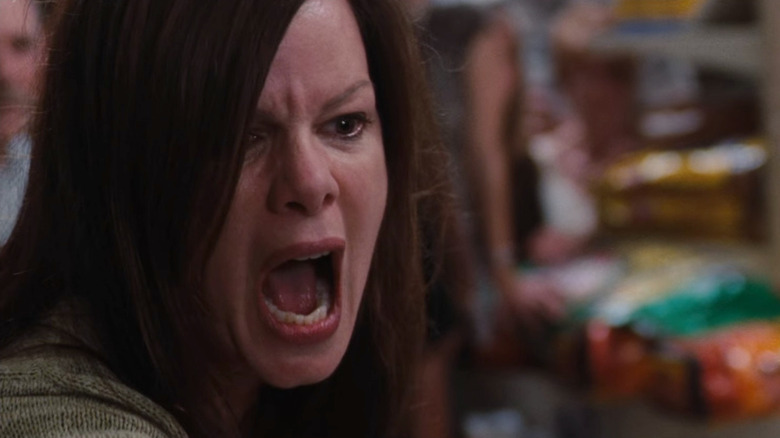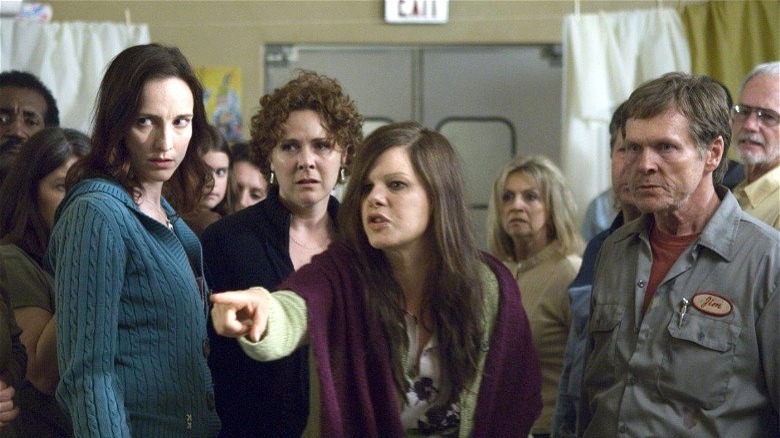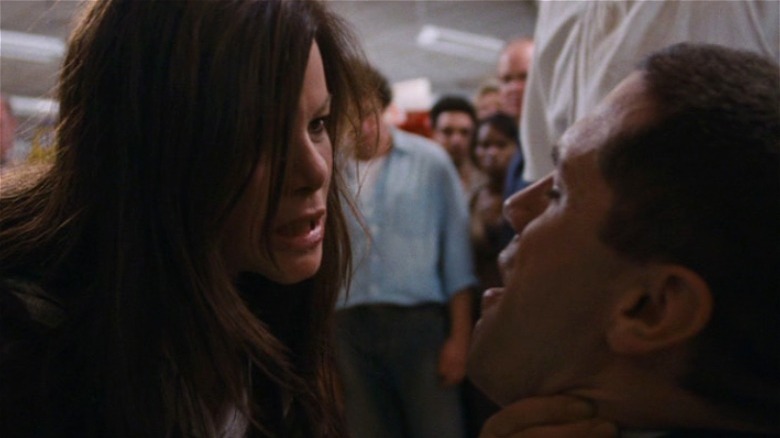How The Mist's Most Terrifying Scene Came Together [Exclusive]
Frank Darabont's "The Mist," an adaptation of the Stephen King novella of the same name, sported atmospheric terror, tentacled monsters surrounding a supermarket, and an unconventional, gut-wrenching ending. Most of the film is set inside a boxed-in space where tensions rise as the horror escalates, as the residents of Bridgton have nowhere to run. One of the residents, Mrs. Carmody (Marcia Gay Harden), interprets this eldritch terror as a religious armageddon and makes matters worse when she attempts to preach to and convert the survivors in an overzealous manner.
There is ample creepiness in "The Mist," in the form of swarming insects at nightfall and alien entities that manage to break into the store. However, the most terrifying aspect of the film is the fanatical Mrs. Carmody, who becomes a cult leader of sorts and convinces the new converts to sacrifice the survivors to appease the creatures. Carmody zeroes in on Private Jessup (Sam Witwer) and offers him up as a "meal" for the creatures, and the poor man is immediately devoured the moment he is thrown outside the supermarket.
For Eric Vespe's recent 15th-anniversary oral history of "The Mist" for /Film, he spoke to Witwer about the human sacrifice scene and the psychology of his character throughout the film. Vespe also asked co-producer Denise Huth and director of photography Rohn Schmidt about the mechanics of the Mrs. Carmody scenes, and why her monstrous behavior was more frightening than any many-legged creature that torment the characters in "The Mist."
Fear-mongering can bring out the worst in us
The fact that Mrs. Carmody targets Jessup as the first sacrifice to further her zealous agenda is exceptionally cruel, as the man is completely innocent in this scenario. Carmody and her converts are driven mad with fear and need a scapegoat to justify their beliefs, which are rooted in ignorance and misdirected rage. Huth told /Film that it is undoubtedly "the scariest scene in the whole movie" as these people end up being more ruthless and monstrous than the actual entities in the film. She said:
"People who are so afraid that they will do anything will do things they never would've imagined they could have done. They stab this man repeatedly and then throw him out to the creatures. And in their minds, it's the right thing to do. In their minds, it's completely justifiable and that is the most terrifying thing in the entire movie."
Huth, who channels heartbreaking physical mannerisms as his character is being stabbed, explained that he mimicked "baby hands" to evoke a certain sense of helplessness. Throughout the film, Jessup's body language becomes more subdued and meek due to the terror that unfolds around him, and this feeling peaks when he is brutally murdered by the mob. The utter injustice of the situation hits harder due to Jessup's demeanor, which is juxtaposed with the mob's cruel aggression.
How this infuriating, heartbreaking scene was shot
Schmidt, who created the haunting cinematography for "The Mist," told /Film that the Jessup sacrifice scene was shot using the widest lens in order to capture the dramatic nature of the event. The narrow aisles of the supermarket heightened the terror of Jessup being repeatedly stabbed and dragged toward the exit, and Schmidt explained that the scene came together with the help of every cast and crew member who brought their A-game:
"Everybody brought it to that scene. Frank [Darabont] whipped them up into a frenzy and it was a little terrifying. You just looked at each other and went, 'Okay, this is a little creepy and scary,' just a little too real sometimes."
Schmidt also talked about the recurring extras who added a sinister layer to the escalating mob mentality inside the supermarket. After shooting for weeks on end, it was important to capture the evolving viciousness of the mob headed by Mrs. Carmody, as it was crucial for "communicat[ing] the terror" that resided in a space that is supposed to be safe. This, combined with Huth's emotive gestures that captured his resignation to his fate, elevates the trepidation embedded in the scene, making it the most horrific scene in "The Mist."


